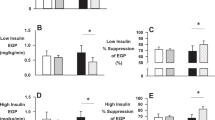Abstract
The aim of this study was to investigate serum chemerin and insulin sensitivity alterations due to exercise training below and above lactate thresholds in streptozocin-induced diabetic rats. Twenty-four rats (190 ± 14 g) were randomly assigned to three groups of control (CON), above lactate thresholds (ALT) and below lactate thresholds (BLT) (n = 8). Then after induction of diabetes, BLT and ALT performed an 8-week exercise program on treadmill running (15 and 27 m/min, respectively) at 0° slope, 1 h/day, and 5 days/week. SPSS version 16 was used for data analysis. The findings showed that, BLT serum chemerin decreased −27 % compared to CON that was statistically significant (p = 0.042), fasting Glucose level of ALT was significantly decreased 19 % compared to CON after 8-week training protocol (p = 0.02). Also 24 % significant reduction was observed in BLT in comparison to CON (p = 0.005). Insulin sensitivity of BLT and ALT improved 7 and 5 %, respectively, compared to CON and both were not significant. Also, positive correlationship was observed between fasting plasma glucose and serum chemerin but it was not significant statistically. Negative correlationship was seen between plasma insulin level and chemerin concentrations and it was not significant too. Compared with CON, BLT weight was significantly reduced 12 % (p = 0.012). Also 9 % weight loss was observed in ALT due to 8-week exercise training which was not statistically significant (p = 0.058). In summary, 8-week exercise training below lactate thresholds may reduce serum chemerin and improve fasting glucose levels.
Similar content being viewed by others
References
Zabel BA et al (2008) Mast cell–expressed orphan receptor CCRL2 binds chemerin and is required for optimal induction of IgE-mediated passive cutaneous anaphylaxis. J Exp Med 205(10):2207–2220
Cash JL et al (2008) Synthetic chemerin-derived peptides suppress inflammation through ChemR23. J Exp Med 205(4):767–775
Barnea G et al (2008) The genetic design of signaling cascades to record receptor activation. Proc Natl Acad Sci 105(1):64–69
Takahashi M et al (2008) Chemerin enhances insulin signaling and potentiates insulin-stimulated glucose uptake in 3T3-L1 adipocytes. FEBS Lett 582(5):573–578
Becker M et al (2010) Expression of human chemerin induces insulin resistance in the skeletal muscle but does not affect weight, lipid levels, and atherosclerosis in LDL receptor knockout mice on high-fat diet. Diabetes 59(11):2898–2903
Jashni HK, Mohebbi H et al (2015) Caloric restriction and exercise training, combined, not solely improve total plasma adiponectin and glucose homeostasis in streptozocin-induced diabetic rats. Sport Sci Health 11(1):81–86
Malin S et al (2014) Exercise-induced lowering of chemerin is associated with reduced cardiometabolic risk and glucose-stimulated insulin secretion in older adults. J Nutr Health Aging 18(6):608–615
Chakaroun R et al (2012) Effects of weight loss and exercise on chemerin serum concentrations and adipose tissue expression in human obesity. Metabolism 61(5):706–714
Bauer S et al (2012) Adipocyte chemerin release is induced by insulin without being translated to higher levels in vivo. Eur J Clin Invest 42(11):1213–1220
Brun J-F, Romain AJ et al (2012) Measurement and physiological relevance of the maximal lipid oxidation rate during exercise (LIPOXmax). INTECH Open Access Publisher
Saremi A et al (2010) Twelve-week aerobic training decreases chemerin level and improves cardiometabolic risk factors in overweight and obese men. Asian J Sports Med 1(3):151
Østergård T et al (2007) The effect of exercise, training, and inactivity on insulin sensitivity in diabetics and their relatives: what is new? Appl Physiol Nutr Metab 32(3):541–548
Guo Z et al (2007) Cardiac expression of adiponectin and its receptors in streptozotocin-induced diabetic rats. Metabolism 56(10):1363–1371
Carvalho JF, Masuda MO, Pompeu FA (2005) Method for diagnosis and control of aerobic training in rats based on lactate threshold. Comp Biochem Physiol Part A Mol Integr Physiol 140(4):409–413
Garekani ET et al (2011) Exercise training intensity/volume affects plasma and tissue adiponectin concentrations in the male rat. Peptides 32(5):1008–1012
Antuna-Puente B et al (2008) Adipokines: the missing link between insulin resistance and obesity. Diabetes Metab 34(1):2–11
Speakman JR, Mitchell SE (2011) Caloric restriction. Mol Aspects Med 32(3):159–221
Li ZY, Wang P, Miao CY (2011) Adipokines in inflammation, insulin resistance and cardiovascular disease. Clin Exp Pharmacol Physiol 38(12):888–896
Conflict of interest
The authors declare that they have no potential conflicts of interest relevant to this article.
Ethical approval
Exercise protocol for animals was approved by post-graduate committee of University of Guilan and other experimental procedures involving animals were approved in accordance with the ethical standards the Medical Science University of Jahrom Animal Care and Use Committee. All experiments were operated in Islamic Azad University, Jahrom branch. The welfare of animals used for research was respected.
Informed consent
For this type of study formal consent is not required.
Author information
Authors and Affiliations
Corresponding author
Rights and permissions
About this article
Cite this article
Fathi, M., Delpasand, A. & Nastaran, M. Serum chemerin and insulin sensitivity alterations due to exercise training below and above lactate thresholds in streptozocin-induced diabetic rats. Sport Sci Health 11, 211–215 (2015). https://doi.org/10.1007/s11332-015-0227-z
Received:
Accepted:
Published:
Issue Date:
DOI: https://doi.org/10.1007/s11332-015-0227-z




